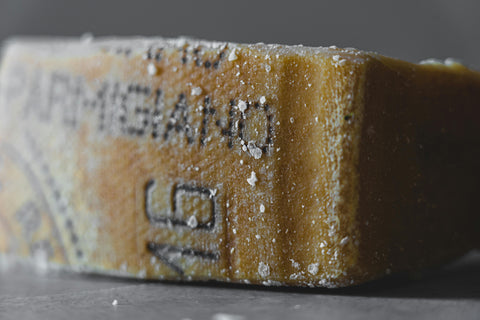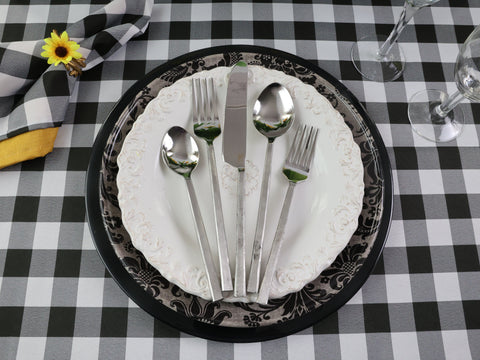What is Parmigiano Reggiano
Parmigiano Reggiano is the most popular cheese in Italy. It is a hard, granular cheese with a rich, nutty, and savory flavor. It is widely used in Italian cuisine, from traditional dishes like risotto to soups and pasta.
Connoisseurs of the cheese will tell you that the flavors are layered, with the first taste slightly sweet and moving into a nutty richness and finishing with a deep umami punch.
Parmesan vs Parmigiano Reggiano
For the record, what we refer to as Parmesan cheese in the US and the cheese we typically buy in stores is not true Parmigiano Reggiano. Parmesan refers to hard cheeses made using similar methods. The word originates from the Italian word “parmigiano”. When you buy Kraft grated Parmesan cheese, you aren’t getting the true Parmigiano Reggiano.
Parmigiano Reggiano is protected by designation of origin (PDO), which means it can only be produced in specific regions of Italy. These regions include Parma, Reggio Emilia, Modena, Bologna, and Mantua. These regions have the ideal climate, soil, and farming practices that produce high-quality milk for Parmigiano Reggiano.
This regulated production and labeling ensures that only cheese made by specific traditional methods can have the name Parmigiano Reggiano.
Use of the term “Parmesan”
According to the Parmigiano Reggiano Consortium, in 2014, the Italian government and the Ministry of Agriculture wanted to strengthen the link between milk producers and cheese production. It was decided that within the European Union, the term Parmesan could only be used to refer to genuine Parmigiano Reggiano.
While the term is more loosely used in the US, there are two ways to know if you are getting genuine Parmigiano Reggiano:
Authentic markings on the rinds. Each wheel of cheese is engraved with its name, using dots to create the markings. Here is an example:

Photo courtesy of Castorly Stock, Pexels.com
Check the label. The name is protected in the US, so only the real cheese that has passed the DOP inspection can be labeled as Parmigiano Reggiano. Look for the name as well as “made in Italy” or “from Italy” on the packaging. This holds whether you buy the cheese in a wedge, block, wheel, or shredded and grated.
How it’s made
What makes Parmigiano Reggiano so unique is that it gets such a rich depth of flavor from only three ingredients: raw cow’s milk, rennet, and salt.
The centuries-old way of making the cheese involves heating the milk in copper vats. Rennet and a starter culture are added to the heated milk to cause it to curdle.

Photo credit: Shore Excursions - Bon Appétit The Essence of Italy
The cheese maker uses a “Spino “to stir the curds and break them down into small granules, which are then cooked and allowed to form a single mass.
Next, the mass is cut into two wheels, which are submerged in a salt and water brine for some time. Once the cheese is deemed salty enough, the wheels are hung up to dry. They are stored in aging rooms, turned and cleaned periodically, for a minimum of 12 months.
Aging can be anywhere from 12 months to 72 months (6 years!). The longer the aging process, the crumblier the cheese…and the higher the price tag.
How to Serve and Enjoy it
A traditional way to enjoy Parmigiano Reggiano is to break it into rough bite-sized chunks. This is said to allow more of the complex flavors of the cheese to reach your taste buds.
Have some balsamic vinegar nearby for drizzling or pair it with some bread.

The workings of this mixed cheese and crudites platter come together deliciously. Served on the Eclipse Round Marble Cheese Board with the Jason cheese tools 4-PC set.
Cheese boards with fresh fruit, including grapes, pears, and strawberries, complement Parmigiano Reggiano, or keep it simple with some nuts like walnuts or hazelnuts.
For wine pairings, a Chianti made from Sangiovese grapes is a top choice. Next would be a Barolo (Nebbiolo), a bold, robust red wine that can easily match up to the intense flavor of Parmigiano Reggiano. And last, but not least, for a nice contrast, try an aged Chardonnay.

The Twisted Urban Cheese Knife 3-PC Set includes a pronged cheese knife. This unique cheese tool is ideal for cheeses like Parmesan and Brie. Guests can cut a piece of cheese and then pick it up with the prongs to place it on a plate. The sharp prongs are also a great tool for breaking up the cheese into chunks.

How are on-trend Italians eating Parmigiano Reggiano? Take chunks and dip them in melted chocolate. It’s the ultimate sweet and salty bite!
How to store it
Store Parmigiano Reggiano in the refrigerator. The ideal temperature is around 39°F (3.8℃) to 46°F (7.8℃). It's best to store it wrapped in plastic wrap or a glass container far from smelly foods.
How long the cheese lasts will depend on how long it's been aged. The younger the cheese, the more moisture it will have. Cheeses that are aged 12-18 months will last about 2 weeks. A 24-month cheese can last for one month if properly stored. And older cheese can last indefinitely.
If mold forms on the cheese, don’t throw it out. Remove that portion with a knife and enjoy the rest of the cheese.
Tip: Freeze the rinds and add them to a pot of soup or beans. The flavor permeates the broth or cooking liquid and adds a fabulous extra layer of flavor to the dish.
Whether you choose to eat Parmigiano Reggiano the traditional way or dipped in semi-sweet chocolate with our selection of artisan cheese boards and cheese knife sets, you’ll be able to serve it up with style.
🧀🧀🧀



